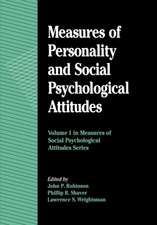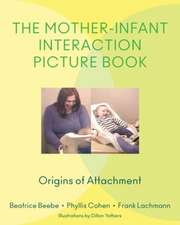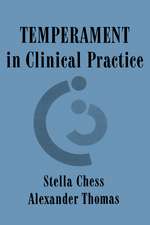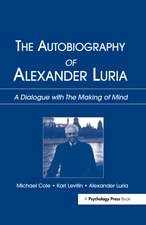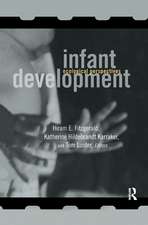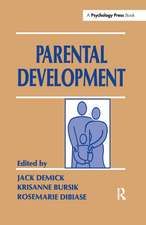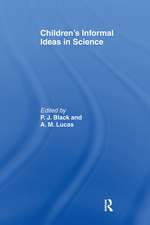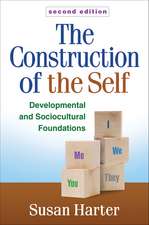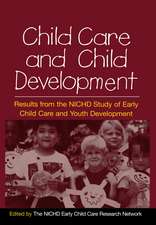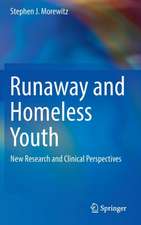Handbook of Attachment: Theory, Research, and Clinical Applications
Editat de Jude Cassidy, Phillip R. Shaveren Limba Engleză Hardback – 9 aug 2016
Widely regarded as the state-of-the-science reference on attachment, this handbook interweaves theory and cutting-edge research with clinical applications. Leading researchers examine the origins and development of attachment theory; present biological and evolutionary perspectives; and explore the role of attachment processes in relationships, including both parent–child and romantic bonds. Implications for mental health and psychotherapy are addressed, with reviews of exemplary attachment-oriented interventions for children and adolescents, adults, couples, and families. Contributors discuss best practices in assessment and critically evaluate available instruments and protocols.
New to This Edition
*Chapters on genetics and epigenetics, psychoneuroimmunology, and sexual mating.
*Chapters on compassion, school readiness, and the caregiving system across the lifespan.
*Chapter probing the relation between attachment and other developmental influences.
*Nearly a decade's worth of theoretical and empirical advances.
New to This Edition
*Chapters on genetics and epigenetics, psychoneuroimmunology, and sexual mating.
*Chapters on compassion, school readiness, and the caregiving system across the lifespan.
*Chapter probing the relation between attachment and other developmental influences.
*Nearly a decade's worth of theoretical and empirical advances.
Preț: 1385.83 lei
Preț vechi: 1458.77 lei
-5% Nou
Puncte Express: 2079
Preț estimativ în valută:
265.26€ • 288.23$ • 222.96£
265.26€ • 288.23$ • 222.96£
Carte tipărită la comandă
Livrare economică 21 aprilie-05 mai
Preluare comenzi: 021 569.72.76
Specificații
ISBN-13: 9781462525294
ISBN-10: 1462525296
Pagini: 1068
Dimensiuni: 178 x 254 x 58 mm
Greutate: 2.04 kg
Ediția:3
Editura: Guilford Publications
Colecția Guilford Press
ISBN-10: 1462525296
Pagini: 1068
Dimensiuni: 178 x 254 x 58 mm
Greutate: 2.04 kg
Ediția:3
Editura: Guilford Publications
Colecția Guilford Press
Public țintă
Postgraduate, Professional, Professional Practice & Development, and UndergraduateCuprins
I. Overview of Attachment Theory
1. The Nature of the Child's Ties, Jude Cassidy
2. Attachment Disruptions, Reparative Processes, and Psychopathology: Theoretical and Clinical Implications, Roger Kobak, Kristyn Zajac, & Stephanie D. Madsen
3. Attachment, Loss, and Grief: Bowlby's Views, New Developments, and Current Controversies, R. Chris Fraley & Phillip R. Shaver
4. The Internal Working Model Construct in Light of Contemporary Neuroimaging Research, Inge Bretherton & Kristine A. Munholland
II. Biological Perspectives
5. Attachment Theory within a Modern Evolutionary Framework, Jeffry A. Simpson & Jay Belsky
6. Psychobiological Origins of Infant Attachment and Its Role in Development, H. Jonathan Polan & Myron A. Hofer
7. Attachment in Rhesus Monkeys, Stephen J. Suomi
8. Attachment, Parenting, and Genetics, Marian J. Bakermans-Kranenburg and Marinus H. van IJzendoorn
9. Attachment and Psychoneuroimmunology, Katherine B. Ehrlich, Gregory E. Miller, Jason D. Jones, & Jude Cassidy
10. Attachment and Temperament as Intersecting Developmental Products and Interacting Developmental Contexts Throughout Infancy and Childhood, Brian E. Vaughn & Kelly K. Bost
11. Studying the Biology of Human Attachment, Amie A. Hane & Nathan A. Fox
12. Toward a Neuroscience of Attachment, James A. Coan
III. Attachment in Infancy and Childhood
13. Normative Development: The Ontogeny of Attachment in Childhood, Robert S. Marvin, Preston A. Britner, & Beth S. Russell
14. Precursors of Attachment Security, R. M. Pasco Fearon & Jay Belsky
15. Attachment Relationships in the Context of Multiple Caregivers, Carollee Howes & Susan Spieker
16. Early Attachment and Later Development: Reframing the Questions, Ross A. Thompson
17. Attachment in Middle Childhood, Kathryn A. Kerns & Laura E. Brumariu
18. The Measurement of Attachment Security and Related Constructs in Infancy and Early Childhood, Judith Solomon & Carol George
IV. Attachment in Adolescence and Adulthood
19. The Multiple Facets of Attachment in Adolescence, Joseph P. Allen & Joseph S. Tan
20. Pair Bonds as Attachments: Mounting Evidence in Support of Bowlby's Hypothesis, Debra M. Zeifman & Cindy Hazan
21. Adult Romantic Attachment: Developments in the Study of Couple Relationships, Judith A. Feeney
22. Attachment and Sexual Mating: The Joint Operation of Separate Motivational Systems, Gurit E. Birnbaum
23. Same-Sex Romantic Attachment, Jonathan J. Mohr & Skyler D. Jackson
24. Adult Attachment and Emotion Regulation, Mario Mikulincer & Phillip R. Shaver
25. Attachment in Middle and Later Life, Carol Magai, Maria Teresa Frías, & Phillip R. Shaver
26. The Adult Attachment Interview: Protocol, Method of Analysis, and Empirical Studies: 1985-2015, Erik Hesse
27. Measurement of Individual Differences in Adult Attachment, Judith A. Crowell, R. Chris Fraley, & Glenn I. Roisman
V. Psychopathology and Clinical Applications
28. Attachment and Psychopathology in Childhood, Michelle DeKlyen & Mark T. Greenberg
29. Attachment Disorganization from Infancy to Adulthood: Neurobiological Correlates, Parenting Contexts, and Pathways to Disorder, Karlen Lyons-Ruth & Deborah Jacobvitz
30. Challenges to the Development of Attachment Relationships Faced by Young Children in Foster and Adoptive Care, Mary Dozier & Michael Rutter
31. Attachment States of Mind and Psychopathology in Adulthood, K. Chase Stovall-McClough & Mary Dozier
32. Prevention and Intervention Programs to Support Early Attachment Security: A Move to the Level of the Community, Lisa J. Berlin, Charles H. Zeanah, & Alicia F. Lieberman
33. Attachment and Adult Psychotherapy: Theory, Research, and Practice, Arietta Slade
34. Reconciling Psychoanalytic Ideas with Attachment Theory, Peter Fonagy, Patrick Luyten, Elizabeth Allison, & Chloe Campbell
35. Couple and Family Therapy: An Attachment Perspective, Audrey Brassard & Susan M. Johnson
VI. Systems, Culture, and Context
36. Caregiving, Brooke C. Feeney & Susan S. Woodhouse
37. Cross-Cultural Patterns of Attachment: Universal and Contextual Dimensions, Judi Mesman, Marinus H. van IJzendoorn, & Abraham Sagi-Schwartz
38. A Lifespan Perspective on Attachment and Care for Others: Empathy, Altruism, and Prosocial Behavior, Phillip R. Shaver, Mario Mikulincer, Jacquelyn T. Gross, Jessica A. Stern, & Jude Cassidy
39. Attachment and Religious Representations and Behavior, Pehr Granqvist & Lee A. Kirkpatrick
40. Divorce through the Lens of Attachment Theory, Brooke C. Feeney & Joan K. Monin
41. Attachment and School Readiness, Amanda P. Williford, Lauren M. Carter, & Robert C. Pianta
42. Implications of Attachment Theory and Research for Child Care Policies, Michael Rutter & Camilla Azis-Clauson
VII. Perspectives on Attachment
43. The Place of Attachment in Development, L. Alan Sroufe
1. The Nature of the Child's Ties, Jude Cassidy
2. Attachment Disruptions, Reparative Processes, and Psychopathology: Theoretical and Clinical Implications, Roger Kobak, Kristyn Zajac, & Stephanie D. Madsen
3. Attachment, Loss, and Grief: Bowlby's Views, New Developments, and Current Controversies, R. Chris Fraley & Phillip R. Shaver
4. The Internal Working Model Construct in Light of Contemporary Neuroimaging Research, Inge Bretherton & Kristine A. Munholland
II. Biological Perspectives
5. Attachment Theory within a Modern Evolutionary Framework, Jeffry A. Simpson & Jay Belsky
6. Psychobiological Origins of Infant Attachment and Its Role in Development, H. Jonathan Polan & Myron A. Hofer
7. Attachment in Rhesus Monkeys, Stephen J. Suomi
8. Attachment, Parenting, and Genetics, Marian J. Bakermans-Kranenburg and Marinus H. van IJzendoorn
9. Attachment and Psychoneuroimmunology, Katherine B. Ehrlich, Gregory E. Miller, Jason D. Jones, & Jude Cassidy
10. Attachment and Temperament as Intersecting Developmental Products and Interacting Developmental Contexts Throughout Infancy and Childhood, Brian E. Vaughn & Kelly K. Bost
11. Studying the Biology of Human Attachment, Amie A. Hane & Nathan A. Fox
12. Toward a Neuroscience of Attachment, James A. Coan
III. Attachment in Infancy and Childhood
13. Normative Development: The Ontogeny of Attachment in Childhood, Robert S. Marvin, Preston A. Britner, & Beth S. Russell
14. Precursors of Attachment Security, R. M. Pasco Fearon & Jay Belsky
15. Attachment Relationships in the Context of Multiple Caregivers, Carollee Howes & Susan Spieker
16. Early Attachment and Later Development: Reframing the Questions, Ross A. Thompson
17. Attachment in Middle Childhood, Kathryn A. Kerns & Laura E. Brumariu
18. The Measurement of Attachment Security and Related Constructs in Infancy and Early Childhood, Judith Solomon & Carol George
IV. Attachment in Adolescence and Adulthood
19. The Multiple Facets of Attachment in Adolescence, Joseph P. Allen & Joseph S. Tan
20. Pair Bonds as Attachments: Mounting Evidence in Support of Bowlby's Hypothesis, Debra M. Zeifman & Cindy Hazan
21. Adult Romantic Attachment: Developments in the Study of Couple Relationships, Judith A. Feeney
22. Attachment and Sexual Mating: The Joint Operation of Separate Motivational Systems, Gurit E. Birnbaum
23. Same-Sex Romantic Attachment, Jonathan J. Mohr & Skyler D. Jackson
24. Adult Attachment and Emotion Regulation, Mario Mikulincer & Phillip R. Shaver
25. Attachment in Middle and Later Life, Carol Magai, Maria Teresa Frías, & Phillip R. Shaver
26. The Adult Attachment Interview: Protocol, Method of Analysis, and Empirical Studies: 1985-2015, Erik Hesse
27. Measurement of Individual Differences in Adult Attachment, Judith A. Crowell, R. Chris Fraley, & Glenn I. Roisman
V. Psychopathology and Clinical Applications
28. Attachment and Psychopathology in Childhood, Michelle DeKlyen & Mark T. Greenberg
29. Attachment Disorganization from Infancy to Adulthood: Neurobiological Correlates, Parenting Contexts, and Pathways to Disorder, Karlen Lyons-Ruth & Deborah Jacobvitz
30. Challenges to the Development of Attachment Relationships Faced by Young Children in Foster and Adoptive Care, Mary Dozier & Michael Rutter
31. Attachment States of Mind and Psychopathology in Adulthood, K. Chase Stovall-McClough & Mary Dozier
32. Prevention and Intervention Programs to Support Early Attachment Security: A Move to the Level of the Community, Lisa J. Berlin, Charles H. Zeanah, & Alicia F. Lieberman
33. Attachment and Adult Psychotherapy: Theory, Research, and Practice, Arietta Slade
34. Reconciling Psychoanalytic Ideas with Attachment Theory, Peter Fonagy, Patrick Luyten, Elizabeth Allison, & Chloe Campbell
35. Couple and Family Therapy: An Attachment Perspective, Audrey Brassard & Susan M. Johnson
VI. Systems, Culture, and Context
36. Caregiving, Brooke C. Feeney & Susan S. Woodhouse
37. Cross-Cultural Patterns of Attachment: Universal and Contextual Dimensions, Judi Mesman, Marinus H. van IJzendoorn, & Abraham Sagi-Schwartz
38. A Lifespan Perspective on Attachment and Care for Others: Empathy, Altruism, and Prosocial Behavior, Phillip R. Shaver, Mario Mikulincer, Jacquelyn T. Gross, Jessica A. Stern, & Jude Cassidy
39. Attachment and Religious Representations and Behavior, Pehr Granqvist & Lee A. Kirkpatrick
40. Divorce through the Lens of Attachment Theory, Brooke C. Feeney & Joan K. Monin
41. Attachment and School Readiness, Amanda P. Williford, Lauren M. Carter, & Robert C. Pianta
42. Implications of Attachment Theory and Research for Child Care Policies, Michael Rutter & Camilla Azis-Clauson
VII. Perspectives on Attachment
43. The Place of Attachment in Development, L. Alan Sroufe
Recenzii
"This third edition of Cassidy and Shaver's Handbook will be an instant classic, like prior editions. The contributors are a 'who's who' in the field. The chapter coverage is exhaustive and timely in its treatment of long-standing and emerging issues in attachment theory and research, such as measurement, biological influences, interventions, and special populations. I use this handbook as the main text in a doctoral seminar on attachment theory and research taken by students in counseling, education, and psychology. Students have found the volume incredibly useful and comment on how it will remain on their shelves. A 'must have' for the researcher or clinician interested in attachment processes across the lifespan."--Richard Lanthier, PhD, Graduate School of Education and Human Development, George Washington University
"Impressive. The list of authors in the third edition includes nearly all of the ongoing major contributors to the attachment literature. Chapters provide important updates, theoretical perspectives, and nuanced discussion. The breadth and depth of the content are stunning. This handbook is required reading for anyone who wants information regarding the current status of attachment theory and research, including students, researchers, and professionals interested in a broad array of topics."--Nancy Eisenberg, PhD, Regents' Professor of Psychology, Arizona State University
"The Handbook of Attachment reflects the kind of artful integration of behavior, emotion, and cognition that John Bowlby and Mary Ainsworth hoped to set in train. I am particularly impressed by the work the editors and contributors to the third edition have devoted to updating, revising, and even reconceptualizing their chapters to keep up with this flourishing field. The third edition is more than just a great help for scholarship and teaching--it is indispensable."--Everett Waters, PhD, Department of Psychology, Stony Brook University
"The Handbook of Attachment, Third Edition, was a superb choice for my advanced undergraduate and graduate seminar. Like the prior editions, the Handbook provides up-to-date coverage of the major topics in the field, as well as exciting explorations of emerging issues. For students who may not yet have a full grasp of the field, the book offers a strong foundation in attachment theory and methodological and clinical implications from which they can start to formulate their own sub-interests. The chapters are written simply enough to make them accessible to upper-level undergraduates, yet also provide sophisticated depth for a more advanced audience. Even after the course, I have heard from students that they frequently consult and reference the Handbook and appreciate having it as an important part of their libraries."--Jennifer C. Ablow, PhD, Department of Psychology, University of Oregon
"This edition is considered the bible of the attachment field, just as the previous two editions were….This third edition is necessary for anybody interested in the attachment field. With the exponential development in the field, this is the place where the updates are synthesized and organized to be easily accessible."--Doody's Review Service
"Has tremendous relevance for clinicians who are interested in the biological, cognitive, and emotional underpinnings of interpersonal relationships, psychopathology, the process of therapy with different clients, and therapeutic change...[and] who wish to understand theory and empirical research relevant to client conceptualization and treatment."--Behavior Therapist (on the second edition)
"A comprehensive and scholarly review of a critically important issue in development attachment....This well-edited volume includes high-quality contributions from leading theorists and researchers in psychology, psychiatry, and child development....The Handbook of Attachment really is a 'must' reference for anyone seriously interested in attachment theory and its role in development across the life span....Practitioners who use attachment theory in their clinical work will find it enlightening."--Journal of Clinical Psychiatry (on the first edition)
"This is an impressive, comprehensive volume which explores a wide range of attachment topics. It should be considered an essential reference book for mental health practitioners who provide treatment to people of all ages."--Psychoanalytic Social Work (on the first edition)
"Destined to become a classic, this comprehensive handbook provides a landmark review and synthesis of the current state of knowledge about attachment and loss in children and adults."--Choice Reviews (on the first edition)
"Impressive. The list of authors in the third edition includes nearly all of the ongoing major contributors to the attachment literature. Chapters provide important updates, theoretical perspectives, and nuanced discussion. The breadth and depth of the content are stunning. This handbook is required reading for anyone who wants information regarding the current status of attachment theory and research, including students, researchers, and professionals interested in a broad array of topics."--Nancy Eisenberg, PhD, Regents' Professor of Psychology, Arizona State University
"The Handbook of Attachment reflects the kind of artful integration of behavior, emotion, and cognition that John Bowlby and Mary Ainsworth hoped to set in train. I am particularly impressed by the work the editors and contributors to the third edition have devoted to updating, revising, and even reconceptualizing their chapters to keep up with this flourishing field. The third edition is more than just a great help for scholarship and teaching--it is indispensable."--Everett Waters, PhD, Department of Psychology, Stony Brook University
"The Handbook of Attachment, Third Edition, was a superb choice for my advanced undergraduate and graduate seminar. Like the prior editions, the Handbook provides up-to-date coverage of the major topics in the field, as well as exciting explorations of emerging issues. For students who may not yet have a full grasp of the field, the book offers a strong foundation in attachment theory and methodological and clinical implications from which they can start to formulate their own sub-interests. The chapters are written simply enough to make them accessible to upper-level undergraduates, yet also provide sophisticated depth for a more advanced audience. Even after the course, I have heard from students that they frequently consult and reference the Handbook and appreciate having it as an important part of their libraries."--Jennifer C. Ablow, PhD, Department of Psychology, University of Oregon
"This edition is considered the bible of the attachment field, just as the previous two editions were….This third edition is necessary for anybody interested in the attachment field. With the exponential development in the field, this is the place where the updates are synthesized and organized to be easily accessible."--Doody's Review Service
"Has tremendous relevance for clinicians who are interested in the biological, cognitive, and emotional underpinnings of interpersonal relationships, psychopathology, the process of therapy with different clients, and therapeutic change...[and] who wish to understand theory and empirical research relevant to client conceptualization and treatment."--Behavior Therapist (on the second edition)
"A comprehensive and scholarly review of a critically important issue in development attachment....This well-edited volume includes high-quality contributions from leading theorists and researchers in psychology, psychiatry, and child development....The Handbook of Attachment really is a 'must' reference for anyone seriously interested in attachment theory and its role in development across the life span....Practitioners who use attachment theory in their clinical work will find it enlightening."--Journal of Clinical Psychiatry (on the first edition)
"This is an impressive, comprehensive volume which explores a wide range of attachment topics. It should be considered an essential reference book for mental health practitioners who provide treatment to people of all ages."--Psychoanalytic Social Work (on the first edition)
"Destined to become a classic, this comprehensive handbook provides a landmark review and synthesis of the current state of knowledge about attachment and loss in children and adults."--Choice Reviews (on the first edition)
Notă biografică
Jude Cassidy, PhD, is Distinguished Scholar-Teacher and Professor of Psychology at the University of Maryland, College Park, and Director of the Maryland Child and Family Development Laboratory. Her research interests include socioemotional development from infancy through adolescence, with an emphasis on attachment and family relationships; social, cognitive, and regulatory mechanisms through which children’s early family experiences come to influence later well-being and relationships; and early intervention designed to reduce the risk of insecure attachment and mental disorders. Her research has been funded by the National Institute of Mental Health, the National Institute of Child Health and Human Development, the National Institute on Drug Abuse, the Substance Abuse and Mental Health Services Administration, and the Zanvyl and Isabelle Krieger Fund. Dr. Cassidy serves as coeditor of the journal Attachment and Human Development and is on the editorial boards ofJournal of Clinical Child and Adolescent Psychology and Infant Mental Health Journal. She is a Fellow of the Association for Psychological Science and the American Psychological Association (APA), and received the Boyd R. McCandless Young Scientist Award from APA Division 7 (Developmental Psychology).
Phillip R. Shaver, PhD, is Distinguished Professor Emeritus of Psychology at the University of California, Davis. He has published several books, including Handbook of Attachment, Third Edition, and over 250 journal articles and book chapters. Dr. Shaver's research focuses on attachment, human motivation and emotion, close relationships, personality development, and the effects of meditation on behavior and brain. He is a fellow of both the American Psychological Association and the Association for Psychological Science, and has served as executive officer of the Society of Experimental Social Psychology (SESP) and as president of the International Association for Relationship Research (IARR). Dr. Shaver is a recipient of Distinguished Career Awards from the SESP, the IARR, and the Society for Personality and Social Psychology, and an honorary doctorate from the Faculty of Social Sciences at the University of Stockholm, Sweden. He is an elected member of the American Academy of Arts and Sciences.
Phillip R. Shaver, PhD, is Distinguished Professor Emeritus of Psychology at the University of California, Davis. He has published several books, including Handbook of Attachment, Third Edition, and over 250 journal articles and book chapters. Dr. Shaver's research focuses on attachment, human motivation and emotion, close relationships, personality development, and the effects of meditation on behavior and brain. He is a fellow of both the American Psychological Association and the Association for Psychological Science, and has served as executive officer of the Society of Experimental Social Psychology (SESP) and as president of the International Association for Relationship Research (IARR). Dr. Shaver is a recipient of Distinguished Career Awards from the SESP, the IARR, and the Society for Personality and Social Psychology, and an honorary doctorate from the Faculty of Social Sciences at the University of Stockholm, Sweden. He is an elected member of the American Academy of Arts and Sciences.
Descriere
Widely regarded as the state-of-the-science reference on attachment, this handbook interweaves theory and cutting-edge research with clinical applications. Leading researchers examine the origins and development of attachment theory; present biological and evolutionary perspectives; and explore the role of attachment processes in relationships, including both parent–child and romantic bonds. Implications for mental health and psychotherapy are addressed, with reviews of exemplary attachment-oriented interventions for children and adolescents, adults, couples, and families. Contributors discuss best practices in assessment and critically evaluate available instruments and protocols.

